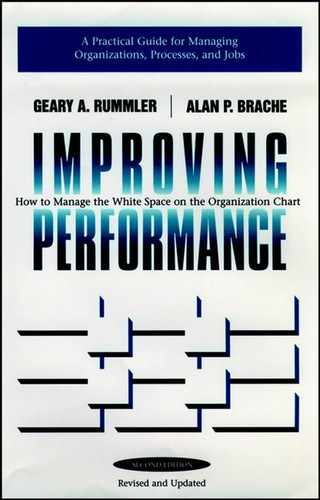16.4. Summary
Our files contain data on more than two hundred performance improvement projects spanning thirty years. They all included applications of Three Levels tools, and they ranged from the macro (establishing speedy cycle time as a competitive advantage in an international electronics company) to micro (improving the performance of machine operators in a snack-food manufacturing company). We continue to find new ways in which all three categories of users—executives, managers, and analysts—are applying the Three Levels as:
A set of tools for diagnosing and eliminating deficient performance
An engine for continuously improving systems that are performing adequately
A road map for guiding an organization in a new direction
A blueprint for designing a new entity
However, Three Levels performance improvement is more than issue-specific interventions. The tools enable managers and individual contributors to bring about many of the culture changes that are frequently discussed but rarely pursued systematically. These culture changes include:
Ensuring that a customer orientation drives all activities
Establishing accountability by objective performance measurement
Minimizing departmental conflicts
Implementing a participative style of management
Creating a work environment that leads to both better performance and a higher quality of work life
We believe that any reader takes no more than a handful of meaningful ideas or tools from even the best of management books. In our opinion, the most significant ideas we have presented are the following:
Organizations behave as adaptive systems. To effectively, nimbly, and proactively adapt to the demands of a rapidly changing environment, all system components—inputs, processes, outputs, and feedback—must be managed.
An organization's strategic and operational effectiveness is the product of Three Levels of Performance—the Organization Level, the Process Level, and the Job/Performer Level. As a result, every improvement effort must be seen through the lens of the Three Levels.
The three Performance Needs that must be met at each of the Three Levels are Goals, Design, and Management. Failure to manage the Nine Performance Variables is failure to manage the business holistically.
Cross-functional processes are particularly critical to the quality, productivity, cycle time, and cost of any business.
Managing people should include addressing the needs of all components of the Human Performance System in which they work.
At each of the Three Levels, there are tools that can help in documenting, analyzing, and improving performance.
We are performance improvement practitioners. We are interested in a theory only if it helps us get results. We have found that the Three Levels framework provides us with a unifying theory of performance improvement. More important, it has led us to the tools we have described and illustrated.
In Chapter One, we described what we see as the challenge facing American companies. A rapidly changing market, higher quality standards, increasing competition, shortages in critical resources, and mind-boggling expansion of technology have become the norm in almost all sectors and all parts of the world. Traditional solutions do not address this new reality.
The approach we have described in this book does not represent a quick fix. We have never experienced a tool that brings about comprehensive, lasting organization change without the investment we have described. The Three Levels viewpoint will enable you to better understand your organization and the variables affecting its performance. With this understanding as a foundation, you can use the Three Levels technique to bring about top-to-bottom performance improvement. We believe that the challenge can be met.
